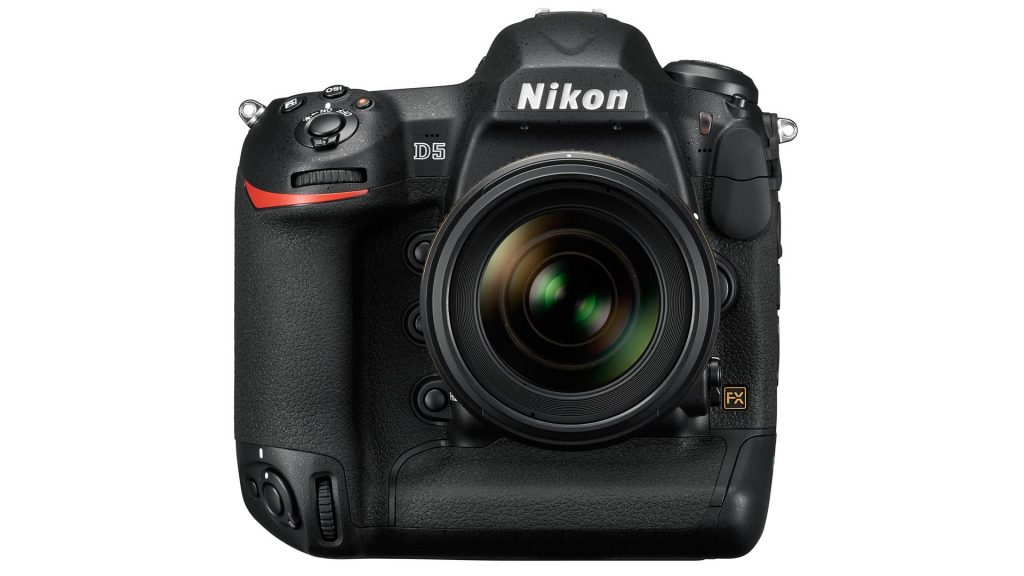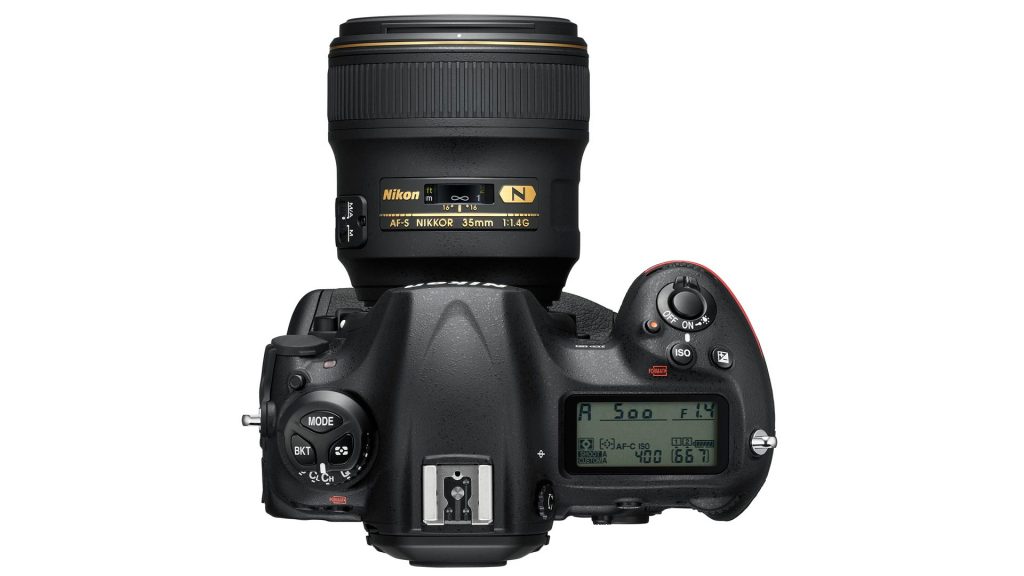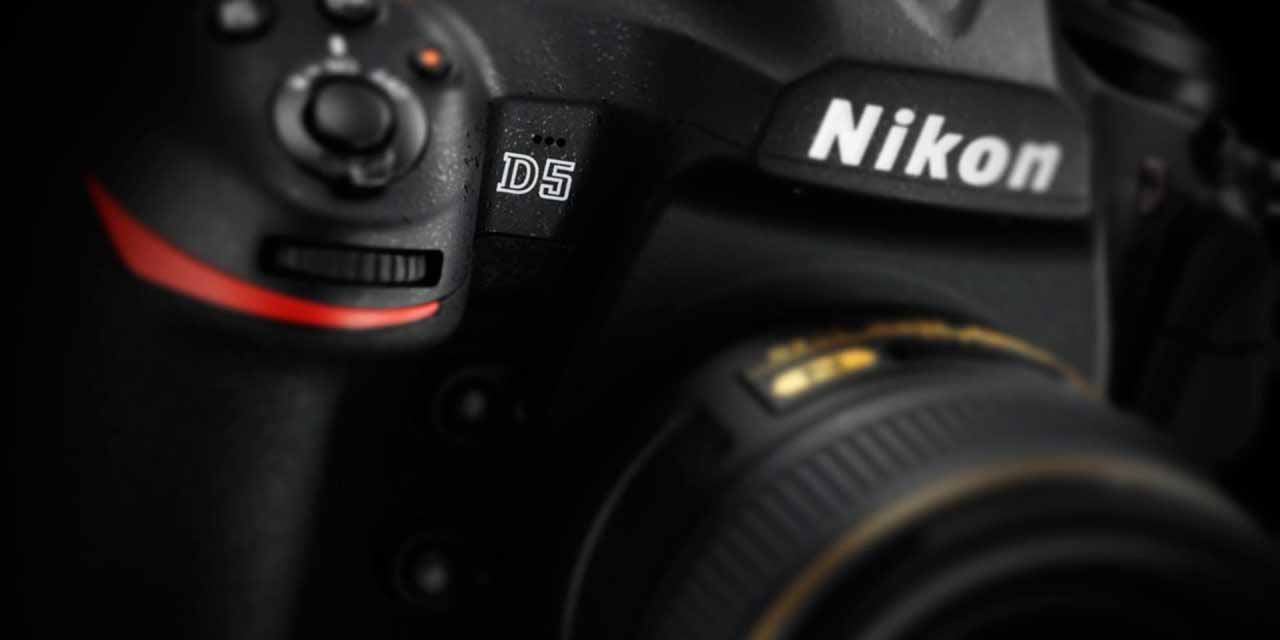Snap Verdict
The Nikon D5 replaces the D4S as Nikon’s top-flight DSLR aimed at professional news and sports photographers. It has a 20.8Mp full-frame sensor and can shoot at a maximum rate of 12fps with full AF and metering function. It’s 153-point focusing system is superb, getting images sharp even in terrible light.
Don’t pay too much attention to the headline-grabbing maximum sensitivity setting (ISO 3,280,000) as the results are awful in the low-light conditions that require that setting. However, images shot at more sensible values like ISO 51,200 look very good indeed. The 4K video footage is also good but as yet it’s only possible to shoot for 3 minutes at a time.
Key features
| Camera type | DSLR |
| Date announced | 5th Jan 2016 |
| Price at launch | £5,199.99/$6,499 (body only |
| Sensor size | Full-frame (35.9 x 23.9mm) |
| Effective pixel count | 20.8 million |
| Processor | Expeed 5 |
| Lens/Mount | F |
| Viewfinder | Optical with pentaprism 100% coverage |
| Sensitivity range | ISO 100-102,400 expandable to ISO 50-3,280,000 |
| Reflex AF system | 153-point with 99 cross-type |
| Live View AF system | Contrast detection |
| Monitor | 3.2-inch TFT LCD with 2,359,000 dots |
| Max shooting rate | 12fps with AF and metering, 14fps with mirror locked-up and AF and metering set on first frame |
| Max video resolution | 4K (8340 x 2160) |
| Storage | 2 XQD or 2 CompactFlash |
| Dimensions | 160 x 158.5 x 92mm |
| Weight | 1405g with battery and two XQD cards |
Top-flight DSLRs don’t get announced that often, but their arrival tends to proceed major sporting events like the Olympic Games. Consequently, with the 2016 Games approaching the announcement of the Nikon D5 to replace the D4S wasn’t a major surprise. It’s maximum sensitivity setting of ISO 3,280,000, however, has raised a few eyebrows.
Inside the D5 is a full-frame (FX) image sensor with 20.8 million effective pixels paired with an Expeed 5 processing engine to allow a native sensitivity range of ISO 100-102,400 (expandable to ISO 50-3,280,000) and a maximum continuous shooting rate of 12fps (frames per second) with continuous autofocusing and metering.
It’s also possible to shoot at 14fps with the focus and exposure set at the start of the sequence and the mirror locked-up so the viewfinder is blacked-out.
Nikon makes two versions of the D5, one with two CF card slots and one with two XQD card slots. The XQD model is capable of recording up to 200 raw files at the maximum shooting rate, but the slower reading time of CF cards cuts this roughly in half.
The D5 is designed for professional news and sports photographers so naturally there’s a high-specification autofocus system. Of the 153 AF-points, 99 are cross-type and the central point is sensitive down to a claimed -4EV. Up to 55 of the points are individually selectable, although its possible to limit this to 15, and the rest are support points.
The camera can be set to operate in single-point, 25-, 72- or 153-point dynamic-area AF, 3D tracking, group-area AF or Auto-area AF mode, giving plenty of control over how it finds and follows moving subjects.
In addition to Full HD, the 5D is capable of recording 4K video footage, but this is limited to just 3 minutes. According to Nikon Pro magazine this is set to be raised to the same limit as Full HD (29mins 59 sec) with a firmware upgrade but it hasn’t been issued yet.
Nikon D5 Build and handling
Just like the camera it replaces, the D5 is a big camera with a twin-grip design and a tough, metal-bodied and weather-sealed construction.

While some D4S users maybe pleased that the new camera has the same control layout, others maybe disappointed that Nikon hasn’t ironed out a few handling issues.
The two Sub-selectors that are used to set AF point, for example, are in different locations relative to the grips that they are designed to be used with. This means that you need to remember to reach your thumb in a different direction when you switch from holding the horizontal grip to the vertical one.

The use of the ‘i’ and ‘Info’ buttons could also be better thought out. Pressing the ‘Info’ button reveals a selection of the most important settings, but they can’t be selected for adjustment.
Meanwhile the list of features displayed on pressing the ‘i’ button seems a little odd including aspects such as Color Space and Custom control assignment which are unlikely to be changed on a frequent basis. It would be better if this list were customisable.
On the back of the D5 is a 3.2-inch 2,359,000-dot screen, which has plenty of detail and doesn’t suffer excessively from reflections. It’s also touch-sensitive, but the touch control only used for inputting ext such as a custom Picture Control mode name and in review mode to help with scrolling through images and zooming in to check sharpness. Oddly, it’s not possible to use it to set AF point in live view or video mode.

As you’d expect with Nikon’s flagship DSLR, the viewfinder is large and bright, giving a clear view of the scene without any digital interpretation.
Nikon D5 Performance
In our Nikon D5 review we found that the company’s new flagship camera resolves an impressive amount of detail for a 20Mp camera and noise is controlled well throughout its standard sensitivity range (ISO 100-102,400) – though I’d keep below ISO 102,400 if possible.
It takes a step forward from the D4S producing images with less noise at high sensitivity settings. The results at ISO 409,600, the D4S’s highest sensitivity value, are better from the newer camera, but I still wouldn’t recommend using that setting unless it’s vital to have an image.
As you might imagine, image quality deteriorates as sensitivity continues to rise and in the low light conditions that require the maximum value (ISO 3,280,00) you are likely to struggle to recognise some subjects in the images. But perhaps there could be some surveillance use.
During my testing the D5’s autofocus system put in an excellent performance, getting subjects sharp quickly and keeping moving subjects in focus as they shifted position, even in gloomy lighting. Interestingly, when the continuous autofocus priority in custom menu a1 was set to Focus rather than release the camera became very hesitant in low light dropping the shooting rate dramatically.
However, when it was switched back to the default of Release the vast majority of the shots taken at 12fps were sharp. Clearly it doubts itself a bit more than it should.
As usual, the highest hit rates are achieved by narrowing down the AF point coverage with single AF point often proving to be the best option provided the subject is a suitable size and you can keep the selected point in the right place.
I found 25-point dynamic area AF mode to be one of the most useful options giving a good balance between AF point coverage and ease of keeping a point over a fast moving subject.
In the Standard Picture Control mode, the D5 tends to render natural subjects like landscapes with quite muted tones. I found reducing the Matrix Metering’s suggested exposure setting by 1/3EV or so helped improve saturation.
More vibrant subjects look good without any need to boost colours either through exposure adjustment or changing Picture Control mode. The automatic white balance system also copes well with a wide range of lighting conditions.
Although it’s usually predictable I found the D5’s Matrix metering system seems a little easily affected by very dark or bright areas within the scene so its worth keeping an eye on the histogram view.
Our Nikon D5 review process found that the camera produces very high quality video the current limitations with 4K recording make it an unlikely choice for anyone for wanting to shoot a lot of video.
Nikon D5 Verdict
While the uppermost sensitivity setting is largely pointless, the D5 is a very capable low-light camera and at high sensitivity settings it produces cleaner images than the Canon 1DX Mark II. The autofocus system is also very good and likely to find favour amongst photographers shooting the Olympic Games and the UEFA European Championship matches this summer.
However, it’s not without a few handling issues not least of which is the lack of similarity between the vertical and horizontal grip controls.
READ MORE
Best DSLRs in the world in 2016
Best cameras for beginners in 2016



